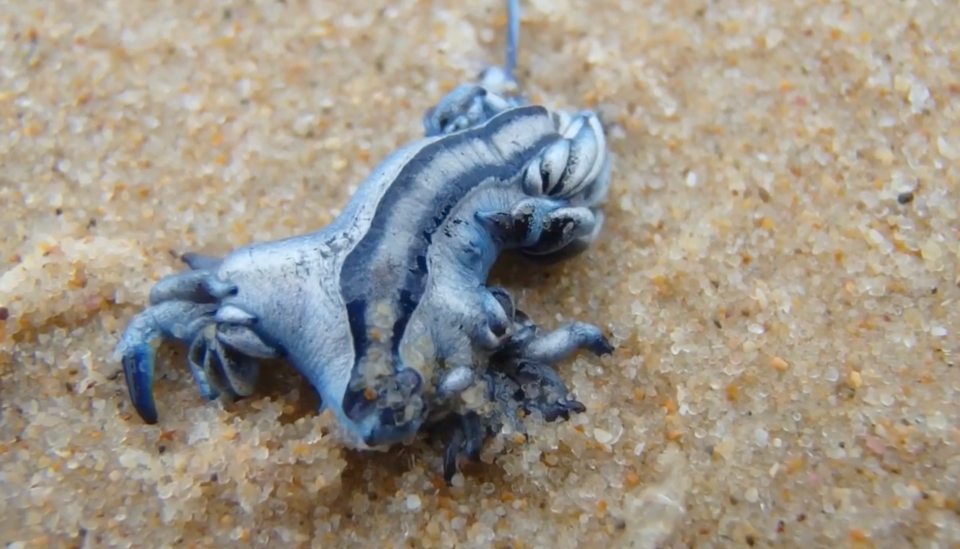TOURISTS have been banned from the waters of a long stretch of Spain’s Costa Blanca due to an invasion of venomous and bizarre “blue dragons”.
Categorised as a sea slug, the deadly creatures are dubbed “the most beautiful killer in the ocean”.
SolarpixThe deadly sea creatures are dubbed ‘the most beautiful killer in the ocean’[/caption]
SolarpixThey have a sting as powerful as the much larger Portuguese Man O’ War[/caption]
SolarpixReg flags went up on beaches in Guardamar del Segura just north of Torrevieja[/caption]
The mysterious and rarely spotted blue seabeast – also known as the blue angel with wings like a dragon – is just over an inch long.
But it has a sting as powerful as the much larger Portuguese Man O’ War – and preys on them too.
The creatures absorb their prey’s venom – concentrating it at the end of their finger-like extremities to ward off attackers.
Although they look like mini Pokemon, the beasts even can turn cannibalistic – sometimes eating each other in captivity.
To protect swimmers on this popular stretch of coastline in Spain, red flags have been put up and lifeguards are voicing warnings with loudhailers.
Reg flags went up on beaches in Guardamar del Segura just north of Torrevieja following the appearance of the blue dragons.
And tourists who defy the bathing ban order risk hefty fines.
Guardamar del Segura’s mayor Jose Luis Saez, confirmed the sea ban order yesterday on X.
He indicated that it would remain in place until further notice: “Red flag on the beaches of Guardamar.
“Bathing is prohibited following the appearance on Vivers Beach of two specimens of Glaucus atlanticus, known as the Blue Dragon.”
Travellers are warned not to touch the blue dragon.
Typical symptoms of the shiny blue dragon’s sting include nausea, pain, vomiting and acute allergic contact dermatitis.
He added: “We remind people that despite its bright and striking colour and its small 1.5 inch size, they should stay away from this animal because of its sting.
“Guardamar del Segura Town Hall has launched a preventive operation to detect possible specimens carried by ocean currents.
“Town hall workers are closely following the evolution of the situation and will inform people about the different measures to be taken.
“If you see one of these creatures don’t touch it, even with gloves on, alert lifeguards and other authorities.
“If you get stung, wash the area affected with salt water and head to your nearest first aid point or health centre.
“These creatures are poisonous and their stings can cause nausea, pain and vomiting.
“For the time being and until further notice, bathing in the sea is prohibited.”
Travellers are warned not to touch the blue dragonsSolarpix
SolarpixTourists risk fines if they enter the water on banned beaches[/caption]
Sunbathers will still be allowed to head to soak up some rays if they don’t take a dip in the sea.
Red flags went up at Santa Barbara beach in La Linea de la Concepcion near Gibraltar on Sunday.
Police had received an emergency call about a blue dragon sighting and six were later found scattered across the shoreline.
The beach was reopened to bathers the following day, with a yellow warning flag up instead of the red one.
Blue dragons wash up across the world, from Spain to Australia. In Sydney in 2018, experts warned people not to touch the mini monsters after large numbers swarmed the coast.
In April this year, Spain was hit by a spectacular invasion of another blue sea creature: a small blue jellyfish.
The Playa del Cura in Gran Canaria was carpeted by tens of thousands of the squidgy By-wind-sailor jellyfish.
What are blue dragons?
The blue dragon, known to scientists as the Glaucus atlanticus, is a brightly coloured ocean drifter.
These creatures spend most of their lives floating upside-down in tropical and subtropical waters.
Their bright blue colour helps them blend into the ocean, camouflaging them from predators.
Other names include blue glaucus, sea swallow, or blue angel.
Although they are tiny, their sting packs a punch. The inch-long sea beasts prey on the much bigger Portuguese Man-O’-War, which are up to 20 times their size.
The blue dragon is a hermaphrodite, meaning it’s both male and female.
While rarely spotted, its small size and wide range around the world means little is known about its conservation status.

